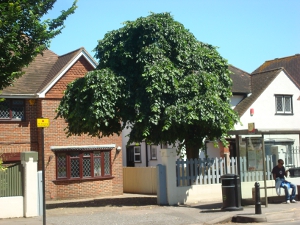Tree Preservation Order - Part Two← Back
Posted 9 Years, 1 Month, 2 Weeks, 2 Days, 21 Hours, 52 Minutes ago.
In the first part of this series (find that here if you missed it), we focused on the basics of Tree Preservation Orders. Here we look in more detail at courses of action required to work on trees with an order.
As a general rule of thumb, you should always seek approval from the Local Authority before carrying out any work to a tree covered by a preservation order.
There are a few instances where this can vary, which are:
1) Cutting down trees in accordance with one of the Forestry Commission's grant schemes, or where a felling license has been granted.
2) Cutting down or pruning a tree:
- which prevents an urgent and serious safety risk, however, you must give written notice of the proposed work through your acting agent to the Local Authority as soon as practicable after the work becomes necessary.
- which is dead - but you must offer 5 working days written notice of the proposed work.
- which is directly in the way of development that is about to start for which detailed planning permission has been granted
- in a commercial orchard, or pruning fruit trees, in accordance with good horticultural practice
- to prevent or control a legal nuisance (always check with your agent and/or a solicitor first)
- In-line with an obligation under an Act of Parliament
- by or at the request of certain organisations listed in the regulations
3) Removing dead branches from a living tree.
ABDS are of course always on hand to offer guidance before and during your projects so please ask us for our assistance.
 Carrying out work on protected trees without consent, or if you cause or permit such activity, can lead to an unlimited fine if it is seen to have deliberately destroyed the tree or if the damage is likely to destroy it. Other offences can lead to a fine of up to £2500!
Carrying out work on protected trees without consent, or if you cause or permit such activity, can lead to an unlimited fine if it is seen to have deliberately destroyed the tree or if the damage is likely to destroy it. Other offences can lead to a fine of up to £2500!
In some instances, a replacement tree may need to be planted. Local Authorities have legal powers to ensure that this is carried out. This occurs when:
- You cut down or destroy a protected tree, in breach of a preservation order or because the tree is dead or dangerous
- If you are given permission to cut down a protected tree but makes re-planting a condition of the consent
- In most cases where a Forestry Commission grants a felling license.
Architectural Building Design Services will work on and submit applications on your behalf if you wish to work in a protected area. With our knowledge and experience, we can outline your options before making the application and therefore minimise the risk of it being rejected. If the application does happen to be refused, or if you are unhappy with the conditions of approval, we can appeal to the Secretary of State for Communities and Local Government in writing within 28 days. The appeal with then be allowed, dismissed or the original conditions varied. There may be times when compensation can be seeked from the authority refusing permission. There must be adequate information to support the case and it must be submitted within 12 months of the decision. Again, we will be happy to guide you through this process using our experience.
Here is some information regarding particular areas that may interest you:
Trees in a Conservation Area
If a tree in a conservation area is already protected from a tree preservation order then normal procedures apply. If a tree is not covered by a preservation order in these areas, then written notice (letter or email) must be given at least six weeks before any work is carried out to give the Local Planning Authority the chance to consider protecting the tree with a tree preservation order. The exception to this rule is if a tree is less than 7.5cm in diameter, measured 1.5m off the ground (or 10cm if thinning to help the growth of other trees). If you are unsure, it is wise to check to avoid heavy fines.
Development Sites
Trees in these areas can be protected by a preservation order or by a condition attached to a planning permission, or both. A planning condition may also require trees to be planted, which may then be protected by a tree preservation order.
be protected by a tree preservation order.
If you have outline planning permission or the development does not require full planning permission (eg, a small home extension) then we will still need to apply for permission to the local authority under the tree preservation order in the normal way.
It is not possible to prevent planning permissions being granted, or to prevent an approved development being carried out, by getting a tree preservation order imposed on trees on the site. Planning permission grants are not declined due to tree presentation orders but it does mean that the risk is considered and where applicable, conditions put in place.
Please contact us for help with your projects in protected areas.
As a general rule of thumb, you should always seek approval from the Local Authority before carrying out any work to a tree covered by a preservation order.
There are a few instances where this can vary, which are:
1) Cutting down trees in accordance with one of the Forestry Commission's grant schemes, or where a felling license has been granted.
2) Cutting down or pruning a tree:
- which prevents an urgent and serious safety risk, however, you must give written notice of the proposed work through your acting agent to the Local Authority as soon as practicable after the work becomes necessary.
- which is dead - but you must offer 5 working days written notice of the proposed work.
- which is directly in the way of development that is about to start for which detailed planning permission has been granted
- in a commercial orchard, or pruning fruit trees, in accordance with good horticultural practice
- to prevent or control a legal nuisance (always check with your agent and/or a solicitor first)
- In-line with an obligation under an Act of Parliament
- by or at the request of certain organisations listed in the regulations
3) Removing dead branches from a living tree.
ABDS are of course always on hand to offer guidance before and during your projects so please ask us for our assistance.
In some instances, a replacement tree may need to be planted. Local Authorities have legal powers to ensure that this is carried out. This occurs when:
- You cut down or destroy a protected tree, in breach of a preservation order or because the tree is dead or dangerous
- If you are given permission to cut down a protected tree but makes re-planting a condition of the consent
- In most cases where a Forestry Commission grants a felling license.
Architectural Building Design Services will work on and submit applications on your behalf if you wish to work in a protected area. With our knowledge and experience, we can outline your options before making the application and therefore minimise the risk of it being rejected. If the application does happen to be refused, or if you are unhappy with the conditions of approval, we can appeal to the Secretary of State for Communities and Local Government in writing within 28 days. The appeal with then be allowed, dismissed or the original conditions varied. There may be times when compensation can be seeked from the authority refusing permission. There must be adequate information to support the case and it must be submitted within 12 months of the decision. Again, we will be happy to guide you through this process using our experience.
Here is some information regarding particular areas that may interest you:
Trees in a Conservation Area
If a tree in a conservation area is already protected from a tree preservation order then normal procedures apply. If a tree is not covered by a preservation order in these areas, then written notice (letter or email) must be given at least six weeks before any work is carried out to give the Local Planning Authority the chance to consider protecting the tree with a tree preservation order. The exception to this rule is if a tree is less than 7.5cm in diameter, measured 1.5m off the ground (or 10cm if thinning to help the growth of other trees). If you are unsure, it is wise to check to avoid heavy fines.
Development Sites
Trees in these areas can be protected by a preservation order or by a condition attached to a planning permission, or both. A planning condition may also require trees to be planted, which may then
If you have outline planning permission or the development does not require full planning permission (eg, a small home extension) then we will still need to apply for permission to the local authority under the tree preservation order in the normal way.
It is not possible to prevent planning permissions being granted, or to prevent an approved development being carried out, by getting a tree preservation order imposed on trees on the site. Planning permission grants are not declined due to tree presentation orders but it does mean that the risk is considered and where applicable, conditions put in place.
Please contact us for help with your projects in protected areas.
